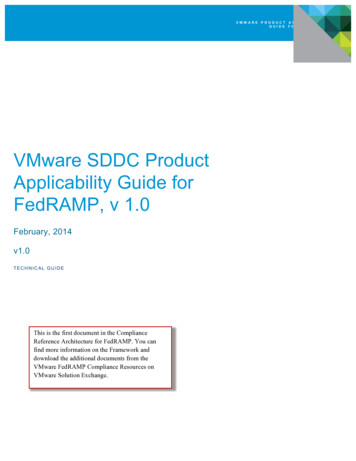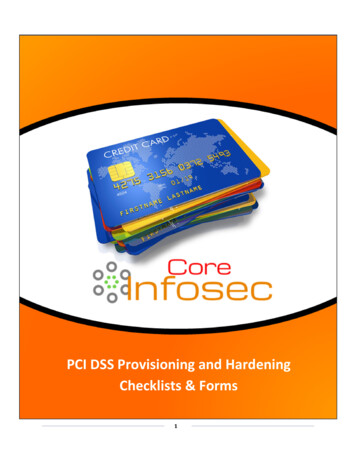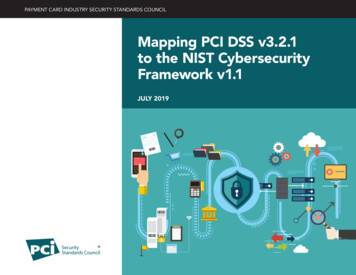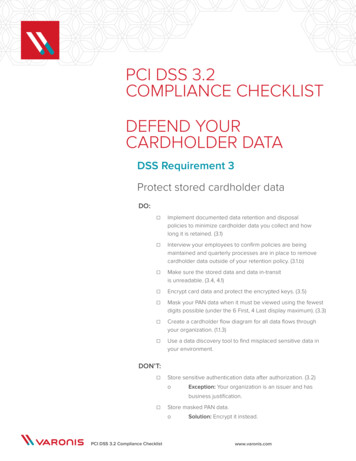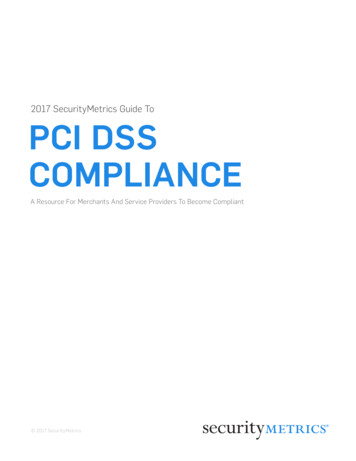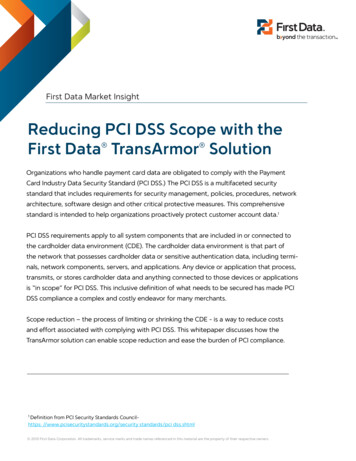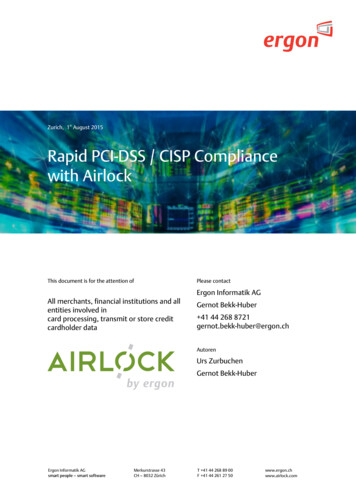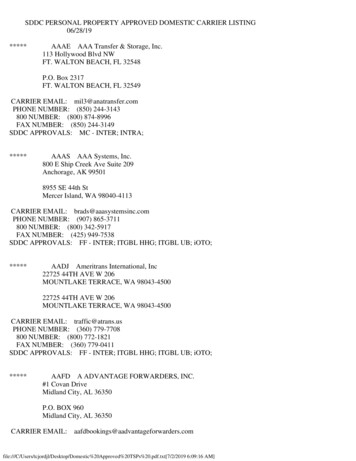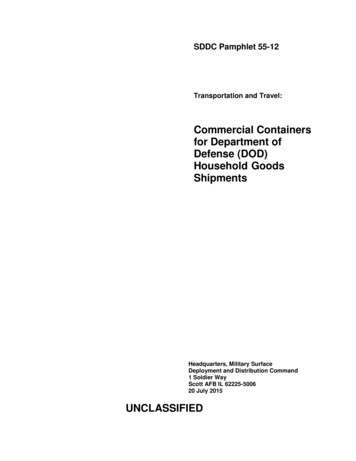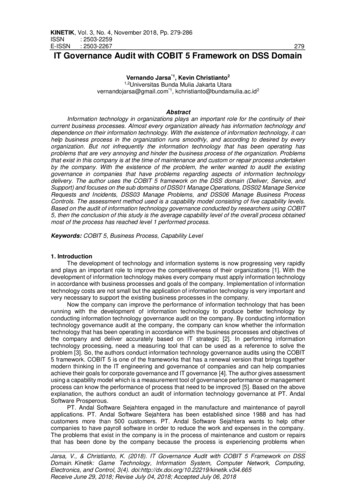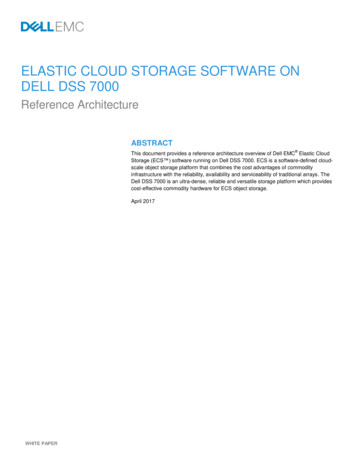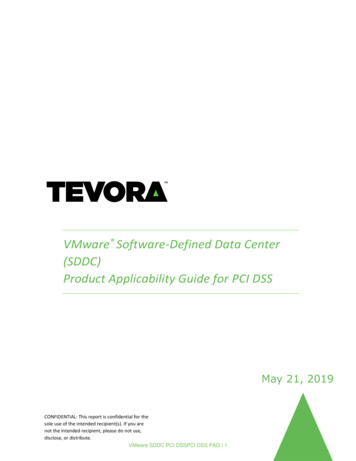
Transcription
VMware Software-Defined Data Center(SDDC)Product Applicability Guide for PCI DSSMay 21, 2019CONFIDENTIAL: This report is confidential for thesole use of the intended recipient(s). If you arenot the intended recipient, please do not use,disclose, or distribute.VMware SDDC PCI DSSPCI DSS PAG 1
VMware SDDC PCI DSS Product Applicability GuideTable of ContentsWHITEPAPER SUBTITLE GOES HERE . 1TABLE OF CONTENTS . 2REVISION HISTORY . 3DESIGN SUBJECT MATTER EXPERTS . 3TRADEMARKS AND OTHER INTELLECTUAL PROPERTY NOTICES . 4EXECUTIVE SUMMARY . 5BACKGROUND . 5VMWARE SDDC AND PCI DSS . 5INTRODUCTION . 7WHAT IS PCI DSS V3.2.1? . 7HOW DOES PCI DSS WORK? . 7SCOPE AND APPROACH . 8OUR APPROACH . 9IN-SCOPE VMWARE PRODUCT LIST . 11OVERVIEW OF VMWARE AND PCI DSS BEST PRACTICES AND REQUIREMENT MAPPING . 14VMWARE CONTROL CAPABILITIES DETAIL . 17VMWARE ADMINISTRATIVE SUPPORT FOR PCI REQUIREMENTS . 18VMWARE CORE SUPPORT FOR PCI REQUIREMENTS. 18CONCLUSION . 41BIBLIOGRAPHY . 42APPENDIX A: PCI DSS 3.2.1 CONTROL MAPPING . 43APPENDIX B: SDDC PRODUCT CAPABILITY RELATIONSHIP WITH PCI DSS . 44ABOUT VMWARE . 65ABOUT TEVORA . 66VMware SDDC PCI DSS PAG 2
VMware SDDC PCI DSS Product Applicability GuideRevision HistoryDateRevAuthorCommentsReviewersMay 20191.0TevoraInitial DraftVMwareDesign Subject Matter ExpertsThe following people provided key input into this whitepaper.NameEmail AddressRole/CommentsDavid Grazerdgrazer@tevora.comCo-AuthorChristina Whitingcwhiting@tevora.comCo-AuthorZachary Curleyzcurley@tevora.comCo-AuthorAnthony Dukesadukes@vmware.comTechnology SME, VMwareCarlos PhoenixJerry ance and Cybersecurity SME, VMwareDirector, Product Management, Compliance Solutions,VMwareVMware SDDC PCI DSS PAG 3
VMware SDDC PCI DSS Product Applicability GuideTrademarks and Other Intellectual Property NoticesThe VMware products and solutions discussed in this document are protected by U.S. and international copyright andintellectual property laws. VMware products are covered by one or more patents listed athttp://www.vmware.com/go/patents. VMware is a registered trademark or trademark of VMware, Inc. and itssubsidiaries in the United States and other jurisdictions. All other marks and names mentioned herein may betrademarks of their respective companies.Solution AreaKey ProductsSoftware-Defined ComputeVMware ESXi , VMware vCenter , VMware Cloud Foundation , VMwarevSAN , VMware vCloud Director , VMware vCloud Director Extender,VMware vCloud Usage MeterSoftware-Defined NetworkingManagement and AutomationDisaster Recovery AutomationVMware NSX VMware vRealize Network Insight , VMware vRealize Automation ,VMware vRealize Orchestrator , VMware vRealize Log Insight , VMwarevRealize Operations Manager , VMware AppDefense , VMware IdentityManager VMware Site Recovery Manager , VMware vSphere Replication , VMwarevCloud Availability for vCloud Director Disclaimer (Tevora)The opinions stated in this guide concerning the applicability of VMware products to the PCI DSS framework arethe opinions of Tevora. All readers are advised to perform individual product evaluations based on organizationalneeds.For more information about the general approach to compliance solutions, please visit VMware SolutionExchange: Compliance and Cyber Risk Solutions. This whitepaper has been reviewed and authored by Tevora’sstaff of Information Security Professionals in conjunction with VMware, Inc.Disclaimer (VMware)This document is intended to provide general guidance for organizations that are considering VMware solutionsto help them address compliance requirements. The information contained in this document is for educationaland informational purposes only. This document is not intended to provide regulatory advice and is provided “ASIS.” VMware makes no claims, promises or guarantees about the accuracy, completeness, or adequacy of theinformation contained herein. Organizations should engage appropriate legal, business, technical, and auditexpertise within their specific organization for review of regulatory compliance requirements.VMware SDDC PCI DSS PAG 4
VMware SDDC PCI DSS Product Applicability GuideExecutive SummaryBackgroundThis Product Applicability Guide (PAG) will provide an evaluation of VMware products that make up and supportthe Software-Defined Data Center (SDDC), and how they may support the Payment Card Industry Data SecurityStandard, v3.2.1 (PCI DSS/PCI) controls. These products virtualize and abstract the physical technology layerssuch as compute, storage, and network, the essence of an SDDC. The changing technology landscape that ismodernizing the data center is also modernizing the virtual desktop environment and mobile devicemanagement while making inroads to consolidate and automate Information Technology (IT) resources. VMwareprioritizes data protection and system security features within the SDDC. The VMware Compliance Solutionsteam developed a framework that incorporates SDDC product capabilities aligned to PCI DSS controls. Theproduct capabilities and framework of this PAG utilized NIST 800-53 as their foundational security framework tocreate a series of standards. These standards have then been used to illustrate how VMware products and theircapabilities apply to other industry frameworks such as NIST 800-171 and PCI DSS.VMware engaged Tevora, an independent third-party IT audit firm, to conduct a review of the SDDC andVMware Cloud solution’s alignment to PCI DSS. This document is the culmination of Tevora’s discussions withVMware product teams to perform a thorough evaluation of VMware product capabilities mapped to PCI DSSrequirements.Tevora is a leading security consulting firm specializing in enterprise risk, compliance, information securitysolutions, and threat research. Tevora offers a comprehensive portfolio of information security solutions andservices to clients in virtually all industries. This PAG will navigate readers through the PCI DSS standard andhighlight applicable VMware product capabilities.VMware SDDC and PCI DSSToday’s infrastructures are heterogeneous in nature, built upon collaborations between internally constructedproducts and third-party sourced components, all guided by a customer’s complex business and compliancerequirements.VMware approaches compliance with a view that understands the complexity in environments and addressesthose areas where virtualization can be leveraged to develop a more secure environment. This focused view oncompliance is reflected in the VMware Compliance Solutions framework, which allows for a wide-rangingadoption of regulatory controls.The phrase “security by design” identifies architectural decisions and default settings inside VMware productsthat are integrated into the product lifecycle. This approach reflects the process VMware follows to weave insecurity through all stages of the product lifecycle, and not as an afterthought. This overlap between productsand compliance requirements marries security and non-security product capabilities in an improved way to alsoachieve operational innovation. Due to the breadth of the NIST compliance framework, VMware selected NIST800-53 as its foundation for all future PAGs including PCI DSS and as the acknowledgment across industrystandards that have been derived from the larger NIST risk framework.VMware SDDC PCI DSS PAG 5
VMware SDDC PCI DSS Product Applicability GuideWhat is SDDC?The Software-Defined Data Center architecture creates a completely automated, highly available environmentfor any application, and any hardware. SDDC can be used in any type of cloud model, and extends the existingconcepts associated with the cloud such as abstraction, pooling, and virtualization across the cloud environment.Features of the SDDC can be deployed as a suite or can also work independently to allow for a controlleddeployment over time.What is PCI DSS?The Payment Card Industry Data Security Standard (PCI DSS) is an information security standard for organizationsthat handle branded credit cards from the major credit card brands. The standard was created to increasesecurity around cardholder data and protect consumers. This standard applies to any organization that stores,processes or handles cardholder data.Cardholder data can consist of several items, including: Primary Account Number (PAN) Name of the cardholder The Card’s expiration date The Card’s service codeAn individual business interaction with cardholder data will vary depending on their defined operations. Thisunderscores that there is no one-size fits all recommendation to secure a cardholder data environment (CDE).The responsibility resides with the individual business to ensure they appropriately assess what requirements fittheir environment to adequately protect cardholder data along PCI DSS standards.Validation of compliance is performed annually, either by an external Qualified Security Assessor (QSA) thatcreates a Report on Compliance (ROC) for organizations handling large volumes of transactions, or by SelfAssessment Questionnaire (SAQ) for companies handling smaller volumes.As with many security standards, PCI DSS takes a variety of its intentions from NIST 800-53 as guidance fordefense in depth security within the cardholder environment.VMware SDDC PCI DSS PAG 6
VMware SDDC PCI DSS Product Applicability GuideIntroductionWhat is PCI DSS v3.2.1?PCI DSS v3.2.1 is an updated version of the PCI Data Security Standard originally developed by PCI Standards Council in2004. This version considers evolving technologies and threat vectors to consumers, merchants and other entitieswithin the transaction chain.How does PCI DSS work?The PCI DSS standard requires organizations to comply with a robust set of requirements. The criteria are brokendown into 6 objective areas and 12 requirements (listed below). Each requirement has a set of controls, thenecessary testing procedures to ensure that they are implemented appropriately with expert guidance. Build and Maintain a Secure Network and Systemso Requirement 1 (Req.1): Install and maintain a firewall configuration to protect cardholder datao Requirement 2 (Req.2): Do not use vendor-supplied defaults for system passwords and other securityparametersProtect Cardholder Datao Requirement 3 (Req.3): Protect stored cardholder datao Requirement 4 (Req.4): Encrypt transmission of cardholder data across open, public networksMaintain a Vulnerability Management Programo Requirement 5 (Req.5): Protect all systems against malware and regularly update anti-virus software orprogramso Requirement 6 (Req.6): Develop and maintain secure systems and applicationsImplement Strong Access Control Measureso Requirement 7 (Req.7): Restrict access to cardholder data by business need to knowo Requirement 8 (Req.8): Identify and authenticate access to system componentso Requirement 9 ((Req.9): Restrict physical access to cardholder dataRegularly Monitor and Test Networkso Requirement 10 (Req.10): Track and monitor all access to network resources and cardholder datao Requirement 11 (Req.11): Regularly test security systems and processes.Maintain an Information Security Policyo Requirement 12 (Req.12): Maintain a policy that addresses information security for all personnel.The scope of the PCI environment varies from organization to organization. VMware products help enforcecontrols configured by each client based on their individual environment. Organizations need to define the scopeof their cardholder environment and controls.VMware SDDC PCI DSS PAG 7
VMware SDDC PCI DSS Product Applicability GuideScope and ApproachThe SDDC and VMware Cloud platform covers a wide number of products and architectures. The platformsand each of their component products contain features that could be mapped to some PCI DSSrequirements. Of the 12 total requirements, 10 had mapping overlaps to VMware software capabilities. Thisguide expands to account for all products underneath the SDDC umbrella. The scope of this guide is limitedto those requirements supported either technically or through direct API integration. People and processcontrols are defined as administrative controls, in support of PCI DSS requirement intents.What Is a Cardholder Data Environment?The CDE is the key area in question within PCI DSS. The CDE can be described as any computer system ornetwork that either processes, stores, or transmits cardholder data or other sensitive payment information.The environment extends to include any device that maintains a direct connection to the device(s) meetingdescription of a CDE as outlined above.The CDE can include but is not limited to any of the following devices: FirewallsSwitchesRoutersAccess PointsPoint of Sale (POS) SystemsPoint of Interaction (POI) DevicesServers (including Webservers, application servers, or database servers)Any application that accepts paymentsAny associated virtual components (including virtual machines (VMs) and virtual networking devices)Third-party support staff or systemsVMware SDDC PCI DSS PAG 8
VMware SDDC PCI DSS Product Applicability GuideOur ApproachThis Product Applicability Guide (PAG) is intended to provide information for all security and compliancepractitioners on Tevora’s recommended usage of the VMware technical stack to address regulatorycompliance obligations and enhance the security of their services through the security and complianceframework of PCI DSS. It is up to each organization to identify how their compliance will be stated and theexpanse of their CDE. The PAG focuses on capabilities of the SDDC product and VMware Cloud at therequirement level. A technical whitepaper, to be released later, will compile information gathered within thisPAG and apply to each individual PCI DSS requirement and their underlying controls.Appendix B outlines specific product capabilities for SDDC and VMware Cloud, and their alignment to PCI DSSrequirements.In addition to the PCI DSS standard requirements, eleven (11) security lenses were used to serve as abaseline to evaluate SDDC and VMware Cloud products. From the ground up, VMware strives to design,define, and deliver compliance solutions to customers. The compliance solution begins with a compliancecontext (e.g., requirements from the appropriate standards in question). Next, the technical requirementsapplicable to the VMware products are mapped to in-scope compliance requirements. Finally, anindependent audit evaluation of the design is conducted. The output is a solution that has interwovencompliance requirements into the end solution available to customers. Below is an overview of this process.Exhibit 1: VMware Compliance Solutions Regulatory Controls MappingVMware SDDC PCI DSS PAG 9
VMware SDDC PCI DSS Product Applicability GuideOutside of the process described above, these eleven (11) areas are broad categories of controls that areimplemented within today’s security programs. They can be used to further understand the broadertechnology concepts used to build security architectures and to implement controls to mitigate risks.The eleven (11) security lenses include: Automated Security System Hardening Compliance Validation System Access Data Segmentation System Monitoring Data Encryption & ProtectionNetwork ProtectionEndpoint ProtectionTrusted Execution/Secure BootSoftware Development Lifecycle(SDLC)Evaluating the SDDC and VMware Cloud through the additional layer of security lenses helps security andcompliance practitioners understand how products deliver the features required not only to supportcompliance with the PCI DSS standard but also to comport with general security best practices.Tevora reviewed the high-level product design, followed by a detailed examination of data flows, features,architectures, and capabilities across all in-scope products to identify applicable controls. The testingconsidered all potential configurations that allow SDDC products to support each requirement.This guide provides executives, technology experts, and security and compliance practitioners with insight toenhance security and compliance postures using VMware products. The SDDC’s flexibility in featuredeployment allows for connection with preexisting systems to further fortify security, privacy, andcompliance. Understanding this flexibility is key to then understanding how VMware products can bedeployed with continuous compliance in mind.Exhibit 2: Percentage of SDDC Products that are capable of meeting the PCI DSS (v. 3.2.1) controls.VMware SDDC PCI DSS PAG 10
VMware SDDC PCI DSS Product Applicability GuideIn-Scope VMware Product ListSoftware-Defined Data Center (SDDC)VMware ESXi 6.0, 6.5, 6.7 – ESXi is a purpose-built bare-metal hypervisor that installs directly onto a physicalserver. With direct access to and control of underlying resources, ESXi is more efficient than hostedarchitectures and can effectively partition hardware to increase consolidation ratios and cut costs forcustomers.VMware v
May 21, 2019 · For more information about the general approach to compliance solutions, please visit VMware Solution Exchange: Compliance and Cyber Risk Solutions. This whitepaper has been reviewed and authored by Tevora’s staff of Information Security Professionals in conjunction with VMware, Inc. Disclaimer (VMware)
